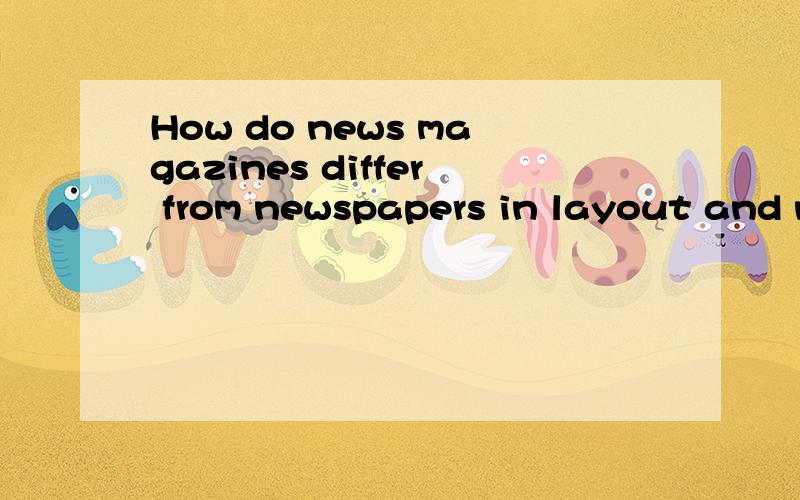How do news magazines differ from newspapers in layout and news coverage?жҳҜвҖңзҫҺиӢұжҠҘеҲҠж–Үз« йҳ…иҜ»вҖқиҜҫзЁӢдёҠзҡ„дёҖдёӘй—®йўҳ,жҲ‘дёҚзҹҘе’Ӣеӣһзӯ”жүҚеҘҪе‘ў?и¶ҠиҜҰз»Ҷи¶ҠеҘҪ,е°Ҫеҝ«!
жқҘжәҗпјҡеӯҰз”ҹдҪңдёҡеё®еҠ©зҪ‘ зј–иҫ‘пјҡдҪңдёҡеё® ж—¶й—ҙпјҡ2024/11/26 16:59:26

How do news magazines differ from newspapers in layout and news coverage?жҳҜвҖңзҫҺиӢұжҠҘеҲҠж–Үз« йҳ…иҜ»вҖқиҜҫзЁӢдёҠзҡ„дёҖдёӘй—®йўҳ,жҲ‘дёҚзҹҘе’Ӣеӣһзӯ”жүҚеҘҪе‘ў?и¶ҠиҜҰз»Ҷи¶ҠеҘҪ,е°Ҫеҝ«!
How do news magazines differ from newspapers in layout and news coverage?жҳҜвҖңзҫҺиӢұжҠҘеҲҠж–Үз« йҳ…иҜ»вҖқиҜҫзЁӢдёҠзҡ„дёҖдёӘй—®йўҳ,жҲ‘дёҚзҹҘе’Ӣеӣһзӯ”жүҚеҘҪе‘ў?и¶ҠиҜҰз»Ҷи¶ҠеҘҪ,е°Ҫеҝ«!
How do news magazines differ from newspapers in layout and news coverage?жҳҜвҖңзҫҺиӢұжҠҘеҲҠж–Үз« йҳ…иҜ»вҖқиҜҫзЁӢдёҠзҡ„дёҖдёӘй—®йўҳ,жҲ‘дёҚзҹҘе’Ӣеӣһзӯ”жүҚеҘҪе‘ў?и¶ҠиҜҰз»Ҷи¶ҠеҘҪ,е°Ҫеҝ«!
жҲ‘еӨӘж— иҜӯдәҶ,дҪ д№ҹжҳҜеҗҢжөҺзҡ„еҗ§.
жҲ‘жӯЈеҮҶеӨҮжҗңиҝҷдёӘзӯ”жЎҲзҡ„,з»“жһңе°ұжҗңеҲ°дҪ дәҶ,иҰҒжҳҜжңүзӯ”жЎҲдәҶеҲ«еҝҳдәҶиҜҙдёҖеЈ°.
иҝҷжҳҜжҲ‘们зҸӯ第дёҖеҗҚеҶҷзҡ„,дҪ зңӢжҖҺд№Ҳж ·?жҲ‘иҖғиҜ•е°ұз”ЁиҝҷдёӘдәҶпјҡ
Layout:в‘ magazines have more pages,colors,pictures.в‘Ўhigh-quality print.в‘ўlonger intervals.News coverage:в‘ mostly focus on political,economic,social news.в‘Ўless timely but more interesting.в‘ўin-depth reports.
жҗӮдё»,cbxжҳҜжҠ„жҲ‘зҡ„,дҪ еҚғдёҮиҰҒзңӢжё…е‘Җ~
1. еүҚиҖ…зҡ„е°ҒйқўеҸӘжңүдёҖдёӘжҳҫи‘—дё»йўҳ,еҗҺиҖ…жңүеӨҡдёӘжҳҫи‘—дё»йўҳеҗҢж—¶еңЁйҰ–йЎөжҠҘзәёдёҠпјҢе…·дҪ“еҶ…е®№еҸҜж №жҚ®йҰ–йЎөдёҠзҡ„зҙўеј•еңЁжҠҘзәёдёӯжүҫеҲ°
2. еүҚиҖ…еҶ…йғЁзј–жҺ’дёҚжҳҺжҳҫпјҢеҗҺиҖ…еҲҶзұ»жҳҺжҳҫгҖӮжҜ”еҰӮпјҡnewsпјҢlocal news, business, jobs, auto, classified
3. еүҚиҖ…еҶ…е®№иҫғж·ұгҖҒеҫҖеҫҖзӢ¬е®¶иҜ„и®әпјӣ еҗҺиҖ…иҫғеҝ«пјҢеҸҜд»ҘжңүиҪ¬иҪҪ
4гҖӮжқӮеҝ—зҡ„еҚ°еҲ·зІҫзҫҺпјҢжҠҘзәёзІ—зіҷдҪҶзҜҮе№…иҫғеӨ§...
е…ЁйғЁеұ•ејҖ
1. еүҚиҖ…зҡ„е°ҒйқўеҸӘжңүдёҖдёӘжҳҫи‘—дё»йўҳ,еҗҺиҖ…жңүеӨҡдёӘжҳҫи‘—дё»йўҳеҗҢж—¶еңЁйҰ–йЎөжҠҘзәёдёҠпјҢе…·дҪ“еҶ…е®№еҸҜж №жҚ®йҰ–йЎөдёҠзҡ„зҙўеј•еңЁжҠҘзәёдёӯжүҫеҲ°
2. еүҚиҖ…еҶ…йғЁзј–жҺ’дёҚжҳҺжҳҫпјҢеҗҺиҖ…еҲҶзұ»жҳҺжҳҫгҖӮжҜ”еҰӮпјҡnewsпјҢlocal news, business, jobs, auto, classified
3. еүҚиҖ…еҶ…е®№иҫғж·ұгҖҒеҫҖеҫҖзӢ¬е®¶иҜ„и®әпјӣ еҗҺиҖ…иҫғеҝ«пјҢеҸҜд»ҘжңүиҪ¬иҪҪ
4гҖӮжқӮеҝ—зҡ„еҚ°еҲ·зІҫзҫҺпјҢжҠҘзәёзІ—зіҷдҪҶзҜҮе№…иҫғеӨ§
收иө·
Most readers will pick up a publication and immediately decide for themselves whether it is a newsletter or a magazine. In general, the differences between newsletters and magazines come down to how t...
е…ЁйғЁеұ•ејҖ
Most readers will pick up a publication and immediately decide for themselves whether it is a newsletter or a magazine. In general, the differences between newsletters and magazines come down to how they are written, who they are written for, and how they are distributed. Additionally, most newsletters and magazines provide visual clues as to their identity. The most common differences between magazines and newsletters are:
Content
Magazine: a periodical publication with articles, stories, or pictures on multiple subjects by multiple authors
Newsletter: a periodical publication with articles about one main subject or topic by one or more authors
Audience
Magazine: written for the general public | typically even special interest magazines are written with a general audience in mind - minimum technical jargon or specialized language
Newsletter: written for a group of people with a common interest | may contain more technical jargon or specialized language not readily understood by the general public that doesn't share the interest or common bonds of the newsletter audience
Distribution
Magazine: available by subscription or from newstands | often heavily supported by advertising
Newsletter: available by subscription to interested parties or distributed to members of an organization | supported primarily by subscriptions, organizational membership fees (club dues), or paid for by the publishing authority (such as an employee newsletter or a marketing newsletter)
Some localities and organizations have their own specific definitions for magazines and newsletters based on readership, distribution, length, or format regardless of what the publication calls itself. Here are some of the criteria someone might use in deciding if a publication is a magazine, newsletter, or other periodical.
Size: Magazines come in a variety of sizes from digest to tabloid size. Newsletters do as well, although letter size is a typical newsletter format.
Length: Most magazines are significantly longer than a newsletter, from a few dozen pages to a few hundred. Newsletters are not generally more than 12-24 pages in length and some may be only 1-2 pages.
Binding: Magazines typically use saddle-stitching or perfect binding depending on the number of pages. Newsletters may not require binding or might use saddle-stitching or simply a staple in the corner.
Layout: The most common, significant visual difference between a magazine and a newsletter is the cover. Magazines usually have a cover that includes the name of the publication, graphics, and perhaps headlines or teasers about what is inside that issue. Newsletters typically have the nameplate and one or more articles right on the front, no separate cover.
Color/Printing: There is no rule that newsletters can't be printed 4-color on glossy paper or that magazines have to be; however, newsletters are more likely to be black and white or spot color publications while magazines are frequently full color glossies.
Print or Pixels
Traditionally, magazines and newsletters were both print publications and most remain so. However, email newsletters are common, especially as a publication in support of a Web site. Print periodicals may also have an electronic version, usually in PDF format. There are also some periodicals that are available only in PDF electronic versions, not in print. With electronic publications there are no obvious visual clues from the layout and type of printing. The content and audience become the main criteria in determining if the publication is a magazine or a newsletter.
收иө·
еӨҡж•°иҜ»иҖ…е°ҶжӢҫиө·еҮәзүҲзү©е’Ңдёә他们иҮӘе·ұз«ӢеҲ»еҶіе®ҡе®ғжҳҜеҗҰжҳҜж—¶дәӢйҖҡи®ҜжҲ–жқӮеҝ—гҖӮ дёҖиҲ¬жқҘиҜҙпјҢеңЁж—¶дәӢйҖҡи®Ҝе’ҢжқӮеҝ—д№Ӣй—ҙзҡ„еҢәеҲ«дёӢжқҘеҲ°д»–们жҖҺд№ҲеҲҶеёғ他们жҖҺж ·иў«еҶҷпјҢ他们被еҶҷпјҢ并且гҖӮ еҸҰеӨ–пјҢеӨҡж•°ж—¶дәӢйҖҡи®Ҝе’ҢжқӮеҝ—жҸҗдҫӣи§Ҷи§үзәҝзҙўиҮідәҺ他们зҡ„иә«еҲҶгҖӮ жқӮеҝ—е’Ңж—¶дәӢйҖҡи®Ҝд№Ӣй—ҙзҡ„е…¬е·®жҳҜпјҡ
Content
Magazine пјҡ дёҺж–Үз« гҖҒж•…дәӢжҲ–иҖ…еӣҫзүҮзҡ„е‘ЁжңҹжҖ§еҮәзүҲзү©еңЁз”ұе№ҝжіӣдҪңиҖ…зҡ„еӨҡдёӘдё»йўҳ
Newsletter пјҡ дёҺж–Үз« зҡ„е‘Ёжңҹ...
е…ЁйғЁеұ•ејҖ
еӨҡж•°иҜ»иҖ…е°ҶжӢҫиө·еҮәзүҲзү©е’Ңдёә他们иҮӘе·ұз«ӢеҲ»еҶіе®ҡе®ғжҳҜеҗҰжҳҜж—¶дәӢйҖҡи®ҜжҲ–жқӮеҝ—гҖӮ дёҖиҲ¬жқҘиҜҙпјҢеңЁж—¶дәӢйҖҡи®Ҝе’ҢжқӮеҝ—д№Ӣй—ҙзҡ„еҢәеҲ«дёӢжқҘеҲ°д»–们жҖҺд№ҲеҲҶеёғ他们жҖҺж ·иў«еҶҷпјҢ他们被еҶҷпјҢ并且гҖӮ еҸҰеӨ–пјҢеӨҡж•°ж—¶дәӢйҖҡи®Ҝе’ҢжқӮеҝ—жҸҗдҫӣи§Ҷи§үзәҝзҙўиҮідәҺ他们зҡ„иә«еҲҶгҖӮ жқӮеҝ—е’Ңж—¶дәӢйҖҡи®Ҝд№Ӣй—ҙзҡ„е…¬е·®жҳҜпјҡ
Content
Magazine пјҡ дёҺж–Үз« гҖҒж•…дәӢжҲ–иҖ…еӣҫзүҮзҡ„е‘ЁжңҹжҖ§еҮәзүҲзү©еңЁз”ұе№ҝжіӣдҪңиҖ…зҡ„еӨҡдёӘдё»йўҳ
Newsletter пјҡ дёҺж–Үз« зҡ„е‘ЁжңҹжҖ§еҮәзүҲзү©е…ідәҺз”ұдёҖдёӘжҲ–жӣҙеӨҡдҪңиҖ…зҡ„дёҖдёӘ主科жҲ–йўҳзӣ®
Audience
Magazine пјҡ еҶҷдёәе…¬дј— | е…ёеһӢең°з”ҡиҖҢзү№ж®ҠеҲ©зӣҠжқӮеҝ—еҶҷжғізқҖдёҖиҲ¬и§Ӯдј—-жһҒе°Ҹзҡ„жҠҖжңҜ专科жңҜиҜӯжҲ–дё“дёҡиҜӯиЁҖ
Newsletter пјҡ еҶҷдёәдёҖзҫӨдәәжңүе…ұеҗҢеҲ©зӣҠзҡ„ | еҸҜд»ҘеҢ…еҗ«дёҚеҲҶдә«ж—¶дәӢйҖҡи®Ҝи§Ӯдј—зҡ„е…ҙи¶ЈжҲ–е…ұеҗҢзҡ„еҖәеҲёзҡ„е…¬дј—жҲ–дё“дёҡиҜӯиЁҖдёҚ欣然дәҶи§Јзҡ„жӣҙеҠ жҠҖжңҜзҡ„专科жңҜиҜӯ
Distribution
Magazine пјҡ еҸҜеҫ—еҲ°з”ұи®ўйҳ…жҲ–д»ҺжҠҘж‘Ҡ | з»ҸеёёжІүйҮҚж”ҜжҢҒйҖҡиҝҮеҒҡе№ҝе‘Ҡ
Newsletter пјҡ еҸҜеҲ©з”Ёз”ұи®ўйҳ…еҜ№ж„ҹе…ҙи¶Јзҡ„дәәжҲ–еҲҶеёғеҜ№з»„з»Үзҡ„жҲҗе‘ҳ | ж”ҜжҢҒдё»иҰҒз”ұи®ўйҳ…пјҢз»„з»Үдјҡе‘ҳиҙ№(дјҡиҙ№)пјҢжҲ–иҖ…ж”Ҝд»ҳз”ұеҮәзүҲзҡ„еҪ“еұҖ(дҫӢеҰӮйӣҮе‘ҳж—¶дәӢйҖҡи®ҜжҲ–иҗҘй”ҖдёҡеҠЎйҖҡдҝЎ)
SomeзҺ°еңәе’Ңз»„з»Үжңүд»–д»¬ж №жҚ®иҜ»иҖ…гҖҒеҸ‘иЎҢгҖҒй•ҝеәҰжҲ–иҖ…ж јејҸе’Ңж—¶дәӢйҖҡи®Ҝзҡ„иҮӘе·ұзҡ„е…·дҪ“е®ҡд№үзҡ„жқӮеҝ—дёҚз®Ўд»Җд№ҲеҮәзүҲзү©з§°иҮӘе·ұгҖӮ иҝҷжҹҗдәәеңЁеҶіе®ҡд№ҹи®ёдҪҝз”Ёзҡ„жҹҗдәӣж ҮеҮҶеҮәзүҲзү©жҳҜеҗҰжҳҜжқӮеҝ—гҖҒж—¶дәӢйҖҡи®ҜпјҢжҲ–иҖ…е…¶д»–жңҹеҲҠгҖӮ
Size пјҡ жқӮеҝ—иҝӣжқҘеҗ„з§Қеҗ„ж ·зҡ„еӨ§е°Ҹд»Һж–Үж‘ҳеҲ°е°ҸжҠҘеӨ§е°ҸгҖӮ ж—¶дәӢйҖҡи®ҜпјҢиҷҪ然дҝЎд»¶еӨ§е°ҸжҳҜдёҖдёӘе…ёеһӢзҡ„ж—¶дәӢйҖҡи®Ҝж јејҸгҖӮ
Length пјҡ еӨҡж•°жқӮеҝ—жҜ”ж—¶дәӢйҖҡи®ҜжҳҫзқҖй•ҝпјҢд»ҺдёҖдәӣ第еҚҒдәҢйЎөеҲ°еҮ зҷҫгҖӮ ж—¶дәӢйҖҡи®Ҝи¶…иҝҮ12-24йЎөе’Ңй•ҝеәҰдёҖдәӣеҸӘд№ҹи®ё1-2йЎөйҖҡеёёдёҚжҳҜгҖӮ
Binding пјҡ жқӮеҝ—ж №жҚ®йЎөзҡ„ж•°йҮҸе…ёеһӢең°дҪҝз”ЁеӨҮйһҚзјқжҲ–ж— зәҝиғ¶и®ўгҖӮ ж—¶дәӢйҖҡи®ҜеңЁи§’иҗҪеҸҜиғҪдёҚиҰҒжұӮжҚҶз»‘д№ҹд№ҹи®ёдёҚдҪҝз”ЁеӨҮйһҚзјқжҲ–е®Ңе…Ёй’үд№Ұй’ҲгҖӮ
Layout пјҡ еңЁжқӮеҝ—е’Ңж—¶дәӢйҖҡи®Ҝд№Ӣй—ҙзҡ„жңҖе…ұеҗҢжҖ§пјҢйҮҚеӨ§и§Ҷи§үеҢәеҲ«жҳҜзӣ–еӯҗгҖӮ жқӮеҝ—йҖҡеёёжңүжҲ–и®ёеҢ…жӢ¬еҮәзүҲзү©гҖҒеӣҫиЎЁе’Ңж ҮйўҳжҲ–иҖ…жҲҸеј„иҖ…зҡ„еҗҚеӯ—е…ідәҺзҡ„зӣ–еӯҗеҸ‘еёғзҡ„д»Җд№Ҳзҡ„жҳҜйҮҢйқўгҖӮ ж—¶дәӢйҖҡи®Ҝе…ёеһӢең°жңүж ҮиҜҶзүҢпјҢ并且дёҖдёӘжҲ–жӣҙеӨҡж–Үз« еңЁеүҚйқўпјҢжІЎжңүеҲҶејҖзҡ„зӣ–еӯҗгҖӮ
Color/Printing пјҡ жІЎжңүиЈҒеҶіж—¶дәӢйҖҡи®ҜдёҚеҸҜиғҪжҳҜеңЁе…үзәёзҡ„жү“еҚ°зҡ„4йўңиүІжҲ–жқӮеҝ—еҝ…йЎ»жҳҜ; 然иҖҢпјҢеҪ“жқӮеҝ—еёёеёёең°жҳҜе®Ңж•ҙиүІеҪ©зҡ„glossiesж—¶пјҢж—¶дәӢйҖҡи®ҜжҳҜеҸҜиғҪжҳҜй»‘зҷҪжҲ–ж–‘зӮ№йўңиүІеҮәзүҲзү©гҖӮ
PrintжҲ–жҳ иұЎзӮ№
TraditionallyгҖҒжқӮеҝ—е’Ңж—¶дәӢйҖҡи®ҜжҳҜеҚ°еҲ·е“ҒеҮәзүҲзү©пјҢ并且еӨҡж•°еҰӮжӯӨдҝқжҢҒгҖӮ 然иҖҢпјҢз”өеӯҗйӮ®д»¶ж—¶дәӢйҖҡи®ҜжҳҜе…ұеҗҢзҡ„пјҢзү№еҲ«жҳҜдҪңдёәеҮәзүҲзү©ж”ҜжҢҒзҪ‘з«ҷгҖӮ еҚ°еҲ·е“ҒжңҹеҲҠд№ҹи®ёд№ҹжңүдёҖдёӘз”өеӯҗзүҲжң¬пјҢйҖҡеёёд»ҘPDFж јејҸгҖӮ д№ҹжңүд»…жңүPDFз”өеӯҗзүҲжң¬зҡ„жңүдәӣжңҹеҲҠпјҢдёҚеңЁеҚ°еҲ·е“ҒгҖӮ з”өеӯҗеҮәзүҲзү©жІЎжңүд»Һжү“еҚ°зҡ„еёғеұҖе’Ңзұ»еһӢзҡ„жҳҺжҳҫзҡ„и§Ҷи§үзәҝзҙўгҖӮ еҶ…е®№е’Ңи§Ӯдј—жҲҗдёәеңЁзЎ®е®ҡеҮәзүҲзү©жҳҜеҗҰзҡ„дё»иҰҒж ҮеҮҶжҳҜжқӮеҝ—жҲ–ж—¶дәӢйҖҡи®ҜгҖӮ
收иө·
ж Үйўҳж„ҸжҖқ:дёәд»Җд№Ҳж–°й—»жқӮеҝ—еңЁеёғеұҖе’ҢжүҖиҝ°ж–°й—»ж–№йқўдёҚеҗҢдәҺжҠҘзәё.
1, жқӮеҝ—жҳҜд№Ұзҡ„еҪўејҸ,иҖҢжҠҘзәёеҸӘжҳҜдёҖеј зәё.
2, жқӮеҝ—дёҖиҲ¬дёҖе‘ЁдёҖдёӘжңҲеҸ‘иЎҢдёҖж¬Ў,дҪҶжҳҜжҠҘзәёжҳҜеҪ“еӨ©зҡ„ж–°й—»,жҠҘзәёе…·жңүж–°йў–жҖ§.
3, жқӮеҝ—дёҖиҲ¬жҸҸиҝ°ж•…дәӢ,жҠҘзәёдёҖиҲ¬жҸҸиҝ°ж—¶дәӢ.
4, жқӮеҝ—дёәж¶ҲйҒЈз”Ё,жҠҘзәёдёәе®ўжҲ·жҸҗдҫӣеҚіж—¶дҝЎжҒҜ....
е…ЁйғЁеұ•ејҖ
ж Үйўҳж„ҸжҖқ:дёәд»Җд№Ҳж–°й—»жқӮеҝ—еңЁеёғеұҖе’ҢжүҖиҝ°ж–°й—»ж–№йқўдёҚеҗҢдәҺжҠҘзәё.
1, жқӮеҝ—жҳҜд№Ұзҡ„еҪўејҸ,иҖҢжҠҘзәёеҸӘжҳҜдёҖеј зәё.
2, жқӮеҝ—дёҖиҲ¬дёҖе‘ЁдёҖдёӘжңҲеҸ‘иЎҢдёҖж¬Ў,дҪҶжҳҜжҠҘзәёжҳҜеҪ“еӨ©зҡ„ж–°й—»,жҠҘзәёе…·жңүж–°йў–жҖ§.
3, жқӮеҝ—дёҖиҲ¬жҸҸиҝ°ж•…дәӢ,жҠҘзәёдёҖиҲ¬жҸҸиҝ°ж—¶дәӢ.
4, жқӮеҝ—дёәж¶ҲйҒЈз”Ё,жҠҘзәёдёәе®ўжҲ·жҸҗдҫӣеҚіж—¶дҝЎжҒҜ.
收иө·
жҘјдё»еҗҢжөҺеӨ§еӯҰзҡ„еҗ§~~е“Ҳе“Ҳ~ж ЎеҸӢе•Ҡ~~
Layout:
в‘ magazines have more pages, colors, pictures.в‘Ўhigh-quality print.в‘ўlonger intervals.
News coverage:
в‘ mostly focus on political, economic, social news. в‘Ўless timely but more interesting. в‘ўin-depth reports.